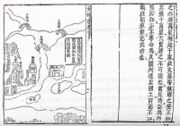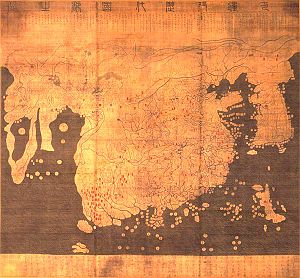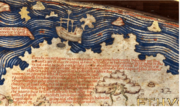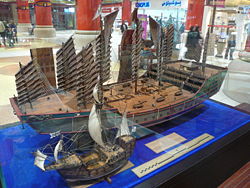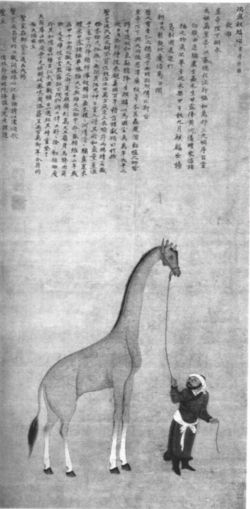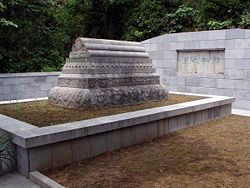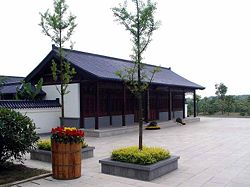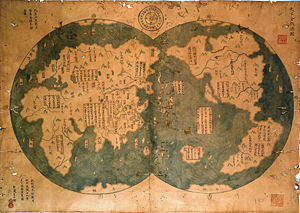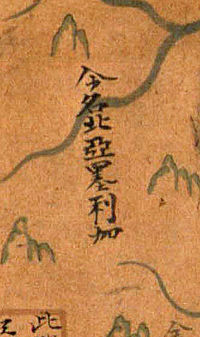Zheng He
2008/9 Schools Wikipedia Selection. Related subjects: General history; Historical figures
Zheng He ( traditional Chinese: 鄭和; simplified Chinese: 郑和; pinyin: Zhèng Hé; Wade-Giles: Cheng Ho; Birth name: 馬三寶 / 马三宝; pinyin: Mǎ Sānbǎo; Arabic/ Persian name: حجّي محمود شمس Hajji Mahmud Shams) ( 1371– 1433), was a Chinese mariner of Hui ethnic descent, explorer, diplomat and fleet admiral, who made the voyages collectively referred to as the travels of "Eunuch Sanbao to the Western Ocean" (Chinese: 三保太監下西洋) or "Zheng He to the Western Ocean", from 1405 to 1433 .
Life
Zheng He was born in 1371 in the Hui ethnic group and the Muslim faith in modern-day Yunnan Province, one of the last possessions of the Mongols of the Yuan Dynasty before being conquered by the Ming Dynasty. He served as a close confidant of the Yongle Emperor of China (reigned 1403– 1424), the third emperor of the Ming Dynasty. Zheng He's ancestors include a general for Genghis Khan.
According to his biography in the History of Ming, he was originally named Ma Sanbao (馬三保), and came from Kunyang (昆阳), present day Jinning (晋宁), Yunnan Province. Zheng belonged to the Semu caste which practiced Islam and were comprised of diverse Turco-Persian groups who entered China. He was a sixth generation descendant of Sayyid Ajjal Shams al-Din Omar, a famous Khwarezmian Yuan governor of Yunnan Province from Bukhara in modern day Uzbekistan. His family name "Ma" came from Shams al-Din's fifth son Masuh (Mansour). Both his father Mir Tekin and grandfather Charameddin had traveled on the hajj to Mecca. Their travels contributed much to the young boy's education. In 1381, following the fall of the Yuan Dynasty, a Mingyuo's fought Ma Sanboa army was dispatched to Yunnan to put down the Mongol rebel Basalawarmi. Zheng He, then only a young boy of eleven years, was taken captive by that army and castrated, thus becoming a eunuch. He soon became a servant at the Imperial court.
The name was given by the Yongle emperor for meritorious service in his coup against the Jianwen Emperor. He studied at Nanjing Taixue (The Imperial Central College). Zheng He travelled to Mecca, though he did not perform the pilgrimage itself.
At the beginning of the 1380s, his tomb was renovated in a more Islamic style, although he himself was buried at sea. The government of the People's Republic of China uses him as a model to integrate the Muslim minority into the Chinese nation. He himself was a living example of religious tolerance, perhaps even syncretism. The Galle Trilingual Inscription set up by Zheng He around 1410 in Sri Lanka records the offerings he made at a Buddhist mountain temple.In around 1431, he set up a commemorative pillar at the temple of the Taoist goddess Tian Fei, the Celestial Spouse, in Fujian province, to whom he and his sailors prayed for safety at sea. This pillar records his veneration for the goddess and his belief in her divine protection, as well as a few details about his voyages. Visitors to the Jinghaisi (静海寺) in Nanjing are reminded of the donations Zheng He made to this non-Muslim area.
Expeditions
Between 1405 and 1433, the Ming government sponsored a series of seven naval expeditions. Emperor Yongle designed them to establish a Chinese presence, impose imperial control over trade, and impress foreign peoples in the Indian Ocean basin. He also might have wanted to extend the tributary system, by which Chinese dynasties traditionally recognized foreign peoples.
Zheng He was placed as the admiral in control of the huge fleet and armed forces that undertook these expeditions. Zheng He's first voyage consisted of a fleet of perhaps 300 ships (other sources say 200) holding almost 28,000 crewmen. These were probably mainly large six-masted ships - it is now thought that the large and flat nine-masted " treasure ships" were probably river ships used by the Emperor.
On the first three voyages, Zheng He visited southeast Asia, India, and Ceylon (today known as Sri Lanka). The fourth expedition went to the Persian Gulf and Arabia, and later expeditions ventured down the east African coast, as far as Malindi in what is now Kenya. Unspecified officials have reportedly endorsed the theory, so far unproven, that one of Zheng He's ships foundered on the rocks near Lamu island, off the coast of today's Kenya, with survivors swimming ashore, marrying locals and creating a family of Chinese-Africans that is now being reunited with the Chinese motherland . Throughout his travels, Zheng He liberally dispensed Chinese gifts of silk, porcelain, and other goods. In return, he received rich and unusual presents from his hosts, including African zebras and giraffes that ended their days in the Ming imperial zoo. Zheng He and his company paid respects to local deities and customs, and in Ceylon they erected a monument honouring Buddha, Allah, and Vishnu.
Zheng He generally sought to attain his goals through diplomacy, and his large army awed most would-be enemies into submission. But a contemporary reported that Zheng He "walked like a tiger", and did not shrink from violence when he considered it necessary to impress foreign peoples with China's military might. He ruthlessly suppressed pirates who had long plagued Chinese and southeast Asian waters. He also intervened in a civil disturbance in order to establish his authority in Ceylon, and he made displays of military force when local officials threatened his fleet in Arabia and East Africa. From his fourth voyage, he brought envoys from thirty states who traveled to China and paid their respects at the Ming court.
In 1424, the Yongle Emperor died. His successor, the Hongxi Emperor (reigned 1424–1425), decided to curb the influence at court. Zheng He made one more voyage under the Xuande Emperor (reigned 1426–1435), but after that Chinese treasure ship fleets ended. Zheng He died during the treasure fleet's last voyage. Although he has a tomb in China, it is empty: he was, like many great admirals, buried at sea.
Zheng He, on his seven voyages, successfully relocated large numbers of Chinese Muslims to Malacca, Palembang, Surabaya and other places and Malacca became the center of Islamic learning and also a large international Islamic trade centre of the southern seas.
His missions showed impressive demonstrations of organizational capability and technological might, but did not lead to significant trade, since Zheng He was an admiral and an official, not a merchant. Chinese merchants continued to trade in Japan and southeast Asia, but Imperial officials gave up any plans to maintain a Chinese presence in the Indian Ocean and even destroyed most of the nautical charts that Zheng He had carefully prepared. The decommissioned treasure ships sat in harbors until they rotted away, and Chinese craftsmen forgot the technology of building such large vessels. -
Voyages
| Order | Time | Regions along the way |
|---|---|---|
| 1st Voyage | 1405-1407 | Champa, Java, Palembang, Malacca, Aru, Sumatra, Lambri, Ceylon, Kollam, Cochin, Calicut |
| 2nd Voyage | 1407-1409 | Champa, Java, Siam, Cochin, Ceylon |
| 3rd Voyage | 1409-1411 | Champa, Java, Malacca, Sumatra, Ceylon, Quilon, Cochin, Calicut, Siam, Lambri, Kaya, Coimbatore, Puttanpur |
| 4th Voyage | 1413-1415 | Champa, Java, Palembang, Malacca, Sumatra, Ceylon, Cochin, Calicut, Kayal, Pahang, Kelantan, Aru, Lambri, Hormuz, Maldives, Mogadishu, Brawa, Malindi, Aden, Muscat, Dhufar |
| 5th Voyage | 1416-1419 | Champa, Pahang, Java, Malacca, Sumatra, Lambri, Ceylon, Sharwayn, Cochin, Calicut, Hormuz, Maldives, Mogadishu, Brawa, Malindi, Aden |
| 6th Voyage | 1421-1422 | Hormuz, East Africa, countries of the Arabian Peninsula |
| 7th Voyage | 1430-1433 | Champa, Java, Palembang, Malacca, Sumatra, Ceylon, Calicut, Hormuz... (17 politics in total) |
Zheng He led seven expeditions to what the Chinese called "the Western Ocean" (Indian Ocean). He brought back to China many trophies and envoys from more than thirty kingdoms — including King Alagonakkara of Ceylon, who came to China to apologize to the Emperor.
The records of Zheng's last two voyages, which are believed to be his farthest, were unfortunately destroyed by the Ming emperor. Therefore it is never certain where Zheng has sailed in these two expeditions. The traditional view is that he went as far as to Iran. The latest view, advanced by Gavin Menzies, suggested Zheng's fleet has travelled every part of the world. However, virtually every authority in the field denounces Menzies' claims as baseless.
There are speculations that some of Zheng's ships may have traveled beyond the Cape of Good Hope. In particular, the Venetian monk and cartographer Fra Mauro describes in his 1459 Fra Mauro map the travels of a huge " junk from India" 2,000 miles into the Atlantic Ocean in 1420. What Fra Mauro meant by 'India' is not known and some scholars believe he meant an Arab ship. Interestingly, Professor Su Ming-Yang thinks "the ship is European, as it is fitted with a crow’s nest, or lookout post, at the masthead, and has sails fitted to the yards, unlike the batten sails of Chinese ships."
Zheng himself wrote of his travels:
We have traversed more than 100,000 li (50,000 kilometers) of immense water spaces and have beheld in the ocean huge waves like mountains rising in the sky, and we have set eyes on barbarian regions far away hidden in a blue transparency of light vapors, while our sails, loftily unfurled like clouds day and night, continued their course [as rapidly] as a star, traversing those savage waves as if we were treading a public thoroughfare… — Tablet erected by Zheng He, Changle, Fujian, 1432. Louise Levathes
His voyages, records, and maps are suggested to be the sources of some of the other Ancient world maps, which are claimed by Menzies to have depicted the Americas, Antarctica, and the tip of Africa before the (European) official discovery and drawings of the Fra Mauro map or the De Virga world map. Menzies conclusions in his book are dismissed by the leading scholars of the subject. The voyages to the Americas, Iceland, Greenland, Australia, and Antarctica by the Chinese Treasure Fleet that Zheng He also commanded, are supported by few others.
Former submarine commander Gavin Menzies in his book 1421: The Year China Discovered the World claims that several parts of Zheng's fleet explored virtually the entire globe, discovering West Africa, North and South America, Greenland, Iceland, Antarctica and Australia (except visiting Europe). Menzies also claimed that Zheng's wooden fleet passed the Arctic Ocean. However none of the citations in 1421 are from Chinese sources and scholars in China do not accept Menzies' assertions. Menzies' statements are controversial and outside the mainstream historical conclusions.
A related book, The Island of Seven Cities: Where the Chinese Settled When They Discovered America by Paul Chiasson maintains that a nation of native peoples known as the Mi'kmaq on the east coast of Canada are descendants of Chinese explorers, offering evidence in the form of archaeological remains, customs, costume, artwork, etc. See 7 Cities for a detailed critique of the book. The archaeological evidence is apparently 20th century.
Size of the ships
Past Chronicles
Treasure ship is the name of a type of vessel that the Chinese admiral Zheng He sailed in. His fleet included 62 treasure ships, sometimes called junks, with some said to have reached 600 feet (146 meters) long. The fleet was manned by over 27,000 crew members, including navigators, explorers, sailors, doctors, workers, and soldiers.
According to ancient Chinese sources, Zheng He commanded seven expeditions. The 1405 expedition consisted of 27,800 men and a fleet of 62 treasure ships supported by approximately 190 smaller ships. The fleet included:
- Treasure ships, used by the commander of the fleet and his deputies (nine-masted, about 126.73 metres (416 ft) long and 51.84 metres (170 ft) wide), according to later writers. Such dimension is more or less the shape of a football field. The treasure ships purportedly can carry as much as 1,500 tons. 1 By way of comparison, a modern ship of about 1,200 tons is 60 meters (200 ft) long , and the ships Christopher Columbus sailed to the New World in 1492 were about 70-100 tons and 17 meter (55 ft) long.
- Horse ships, carrying tribute goods and repair material for the fleet (eight-masted, about 103 m (339 ft) long and 42 m (138 ft) wide).
- Supply ships, containing staple for the crew (seven-masted, about 78 m (257 ft) long and 35 m (115 ft) wide).
- Troop transports, six-masted, about 67 m (220 ft) long and 25 m (83 ft) wide.
- Fuchuan warships, five-masted, about 50 m (165 ft) long.
- Patrol boats, eight-oared, about 37 m (120 feet) long.
- Water tankers, with 1 month supply of fresh water.
Six more expeditions took place, from 1407 to 1433, with fleets of comparable size.
If the accounts can be taken as factual, Zheng He's treasure ships were mammoth ships with nine masts, four decks, and were capable of accommodating more than 500 passengers, as well as a massive amount of cargo. Marco Polo and Ibn Battuta both described multi-masted ships carrying 500 to 1000 passengers in their translated accounts.. Niccolò Da Conti, a contemporary of Zheng He, was also an eyewitness of ships in Southeast Asia, claiming to have seen 5 masted junks weighing about 2000 tons Zheng He's fleet included 300 ships, including 62 treasure ships, with some which were said to have been 137 m (450 ft) long and 55 m (180 ft) wide. There are even some sources that claim some of the treasure ships might have been as long as 600 feet. On the ships, there were over 28,000 people, including navigators, explorers, sailors, doctors, workers, and soldiers.
Chinese records assert that Zheng He's fleet sailed as far as East Africa. However, the amateur historian Gavin Menzies has controversially argued that the fleet went on to reach the New World, landing on islands off the Florida coast more than half a century before Christopher Columbus.
Modern Scholastic Study of Ship Dimension
According to recent research by professor of marine engineering Xin Yuanou, the actual length of the ships has been estimated at 59 m, which has been accepted by modern scholarship as more realistic.
The treasure ships described in Chinese chronicles would have been several times larger than any wooden ship ever recorded since, including the largest, l'Orient (65 m long) in the late 18th century. The first ships to attain 126 m long were 19th century steamers with iron hulls. Some scholars argues that it is highly unlikely that Zheng He's ship was 450 feet in length, some estimating that they were 390-408 feet long and 160-166 feet wide instead while others put them as 200-250 feet in length .
One explanation for the seemingly inefficient size of these colossal ships was that the largest 44 Zhang Treasure Ships were merely used by the Emperor and imperial bureaucrats to travel along the Yangtze for court business, including reviewing Zheng He's expedition fleet. The Yangtze river, with its calmer waters, may be sailable for these Treasure Ships. Zheng He, a court eunuch, would not have the privilege in rank to command the largest of these ships, seaworthy or not. The main ships of Zheng He's fleet were instead 6 masted 2000-liao ships.
Accounts of medieval travellers

The characteristics of the Chinese ships of the period are described by Western travelers to the East, such as Ibn Battuta and Marco Polo. According to Ibn Battuta, who visited China in 1347:
…We stopped in the port of Calicut, in which there were at the time thirteen Chinese vessels, and disembarked. China Sea traveling is done in Chinese ships only, so we shall describe their arrangements. The Chinese vessels are of three kinds; large ships called chunks ( junks), middle sized ones called zaws ( dhows) and the small ones kakams. The large ships have anything from twelve down to three sails, which are made of bamboo rods plaited into mats. They are never lowered, but turned according to the direction of the wind; at anchor they are left floating in the wind. Three smaller ones, the "half", the "third" and the "quarter", accompany each large vessel. These vessels are built in the towns of Zaytun and Sin-Kalan. The vessel has four decks and contains rooms, cabins, and saloons for merchants; a cabin has chambers and a lavatory, and can be locked by its occupants. This is the manner after which they are made; two (parallel) walls of very thick wooden (planking) are raised and across the space between them are placed very thick planks (the bulkheads) secured longitudinally and transversely by means of large nails, each three ells in length. When these walls have thus been built the lower deck is fitted in and the ship is launched before the upper works are finished." (Ibn Battuta).
Zheng He and Islam in Southeast Asia
| History of Islam in China |
|
History |
| Architecture |
|
Chinese mosques |
| Major figures |
|
Lan Yu • Hui Liangyu • Ma Bufang |
| People Groups |
|
Hui • Salar • Uygur |
| Islamic Cities/Regions |
|
Linxia • Xinjiang |
| Culture |
|
Islamic Association of China |
Indonesian religious leader and Islamic scholar Hamka (1908–1981) wrote in 1961: "The development of Islam in Indonesia and Malaya is intimately related to a Chinese Muslim, Admiral Zheng He." In Malacca he built granaries, warehouses and a stockade, and most probably he left behind many of his Muslim crews. Much of the information on Zheng He's voyages was compiled by Ma Huan, also Muslim, who accompanied Zheng He on several of his inspection tours and served as his chronicler / interpreter. In his book 'The Overall Survey of the Ocean Shores' (Chinese: 瀛涯勝覽) written in 1416, Ma Huan gave very detailed accounts of his observations of the peoples' customs and lives in ports they visited. Zheng He had many Muslim Eunuchs as his companions. At the time when his fleet first arrived in Malacca, there were already Chinese of the ' Muslim' faith living there. Ma Huan talks about them as tangren (Chinese: 唐人) who were Muslim. At places they went, they frequented mosques, actively propagated the Islamic faith, established Chinese Muslim communities and built mosques.
Indonesian scholar Slamet Muljana writes: "Zheng He built Chinese Muslim communities first in Palembang, then in San Fa (West Kalimantan), subsequently he founded similar communities along the shores of Java, the Malay Peninsula and the Philippines. They propagated the Islamic faith according to the Hanafi school of thought and in Chinese language."
Li Tong Cai, in his book 'Indonesia – Legends and Facts', writes: "in 1430, Zheng He had already successfully established the foundations of the Hui religion Islam. After his death in 1434, Hajji Yan Ying Yu became the force behind the Chinese Muslim community, and he delegated a few local Chinese as leaders, such as trader Sun Long from Semarang, Peng Rui He and Hajji Peng De Qin. Sun Long and Peng Rui He actively urged the Chinese community to 'Javanise'. They encouraged the younger Chinese generation to assimilate with the Javanese society, to take on Javanese names and their way of life. Sun Long's adopted son Chen Wen, also named Radin Pada is the son of King Majapahit and his Chinese wife."
After Zheng He's death, Chinese naval expeditions were suspended. The Hanafi Islam that Zheng He and his people propagated lost almost all contact with Islam in China, and gradually was totally absorbed by the local Shafi’i school of thought. When Melaka was successively colonised by the Portuguese, the Dutch, and later the British, Chinese were discouraged from converting to Islam. Many of the Chinese Muslim mosques became San Bao Chinese temples commemorating Zheng He. After a lapse of 600 years, the influence of Chinese Muslims in Malacca declined to almost nil. In many ways, Zheng He can be considered a major founder of the present community of Chinese Indonesians.
In Malacca
According to the Malaysian history, Sultan Mansur Shah (ruled 1459–1477) dispatched Tun Perpatih Putih as his envoy to China and carried a letter from the Sultan to the Ming Emperor. Tun Perpatih succeeded in impressing the Emperor of Ming with the fame and grandeur of Sultan Mansur Shah. In the year 1459, a princess Hang Li Po (or Hang Liu), was sent by the emperor of Ming to marry Malacca Sultan Mansur Shah (ruled 1459–1477). The princess came with her entourage 500 male servants and a few hundred handmaidens. They eventually settled in Bukit Cina, Malacca. The descendants of these people, from mixed marriages with the local natives, are known today as Peranakan: Baba (the male title) and Nyonya (the female title).
In Malaysia today, many people believe it was Admiral Zheng He (died 1433) who sent princess Hang Li Po to Malacca in year 1459. However there is no record of Hang Li Po (or Hang Liu) in Ming documents, she is known only from Malacca folklore. In that case, Ma Huan's observation was true, the so-called Peranakan in Malacca was in fact Tang-Ren or Hui Chinese Muslims. These Chinese Muslims together with Parameswara were refugees of the declining Srivijaya kingdom, they came from Palembang, Java and other places. Some of the Chinese Muslims were soldiers and so they served as warrior and bodyguard to protect the Sultanate of Malacca.
On his return trip from China, Parameswara was so impressed by Zheng He that he converted to Islam and adopted the name Sultan Iskandar Shah. Malacca prospered under his leadership and became the half-way house, an entreport, for trade between India and China.
Connection to the history of Late Imperial China
Zheng He's initial objective was to enroll far flung states into the Ming tributary system, but it was later decided that the voyages were not cost efficient. After Zheng's voyages, China turned away from the seas due to the Hai jin order, and was isolated from European technological advancements. Although historians such as John Fairbank and Joseph Needham popularized this view in the 1950s, Han Chinese historians in modern times point out that Chinese maritime commerce did not totally stop after Zheng He, that Chinese ships continued to dominate Southeast Asian commerce until the 19th century and that active Chinese trading with India and East Africa continued long after the time of Zheng. The travels of the Chinese Junk Keying to the United States and England between 1846 and 1848 testify to the power of Chinese shipping until the 19th century. Moreover revisionist historians such as Jack Goldstone argue that the Zheng He voyages ended for practical reasons that did not reflect the technological level of China
Although the Ming Dynasty did ban shipping with the Hai jin edict, they eventually lifted this ban. The alternative view cites the fact that by banning oceangoing shipping, the Ming (and later Qing) dynasties forced countless numbers of people into black market smuggling. This reduced government tax revenue and increased piracy. The lack of an oceangoing navy then left China highly vulnerable to the Wokou pirates that ravaged China in the 16th century.
State-sponsored Ming naval efforts declined dramatically after Zheng's voyages. Starting in the early 15th century, China experienced increasing pressure from resurgent Mongolian tribes from the north. In recognition of this threat and possibly to move closer to his family's historical geographic power base, in 1421 the emperor Yongle moved the capital north from Nanjing to present-day Beijing. From the new capital he could apply greater imperial supervision to the effort to defend the northern borders. At considerable expense, China launched annual military expeditions from Beijing to weaken the Mongolians. The expenditures necessary for these land campaigns directly competed with the funds necessary to continue naval expeditions.
In 1449 Mongolian cavalry ambushed a land expedition personally led by the emperor Zhengtong less than a day's march from the walls of the capital. In the Battle of Tumu Fortress the Mongolians wiped out the Chinese army and captured the emperor. This battle had two salient effects. First, it demonstrated the clear threat posed by the northern nomads. Second, the Mongols caused a political crisis in China when they released Zhengtong after his half-brother had proclaimed himself the new Jingtai emperor. Not until 1457 did political stability return when Zhengtong recovered the throne. Upon his return to power China abandoned the strategy of annual land expeditions and instead embarked upon a massive and expensive expansion of the Great Wall of China. In this environment, funding for naval expeditions simply did not happen.
More fundamentally, unlike the later naval expeditions conducted by European nations, the Chinese treasure ships appear to have been doomed in the long run because the voyages lacked any economic motive. They were primarily conducted to increase the prestige of the emperor and the costs of the expeditions and of the return gifts provided to foreign royalty and ambassadors more than outstripped the benefits of any tribute collected. Thus when China's governmental finances came under pressure (which like all governments' finances they eventually did), funding for the naval expeditions melted away. In contrast, by the 16th century, most European missions of exploration made enough profit from the resulting trade to become self-financing, allowing them to continue regardless of the condition of the state's finances.
Zheng He's tomb and museum
Zheng He's tomb in Nanjing has been repaired and a small museum has been built next to it, although his body is missing as he was buried at sea off the Malabar coast near Calicut in Western India. However, his sword and other personal possessions were interred in the typical Muslim tomb inscribed with Arabic characters.
Zheng He map
In January 2006, BBC News and The Economist both published news regarding the exhibition of a Chinese sailing map claimed to be dated 1763, which was stated to be a copy of another map purportedly made in 1418 . The map has detailed descriptions of both Native Americans and Native Australians. According to the map's owner, Liu Gang, a Chinese lawyer and collector, he purchased the map in 2001 for $500 USD from a Shanghai dealer.
After Liu read the book 1421: The Year China discovered the World by Gavin Menzies, he realized the significant potential value of the map. The map has been tested to verify the age of its paper, but not the ink. Even though the map has been shown to date from a period that could cover 1763, the question remains as to whether it is an accurate copy of an earlier 1418 map, or simply a copy of a contemporary 18th-century European map.
A number of authorities on Chinese history have questioned the authenticity of the map. Some point to the use of the Mercator-style projection, its accurate reckoning of longitude and its North-based orientation. None of these features was used in the best maps made in either Asia or Europe during this period (for example see the Kangnido map (1410) and the Fra Mauro map (1459)). Also mentioned is the depiction of the erroneous Island of California, a mistake commonly repeated in European maps from the sixteenth to eighteenth centuries. On the map the American continent is labelled phonetically "A-me-ri-ca" (亞墨利加), also a clear borrowing from the West.
Geoff Wade of the Asia Research Institute at the National University of Singapore has strongly disputed the authenticity of the map and has suggested that it is either an 18th or 21st-century fake. He has pointed out a number of anachronisms that appear in the map and its text annotations. For example, in the text next to Eastern Europe, which has been translated as "People here mostly believe in God and their religion is called 'Jing' (景, referring to Nestorianism)", Wade notes that the Chinese word for the Christian God is given as " Shang-di" (上帝), which is a usage that was first borrowed from Chinese ancient text by Jesuit missionary Matteo Ricci in the 16th century.
In May 2006, it was reported by the Dominion Post that Fiona Petchey, head of the testing unit at Waikato University, which had carbon dated the map, had asked Gavin Menzies to remove claims from his website that the dating proved the map was genuine. The carbon dating indicated with an 80% probability a date for the paper of the map between either 1640–1690 or 1730–1810. However as the ink was not tested, it was impossible to know when it was drawn. Ms Petchey said, "we asked him to remove those, not because we were not happy with the dates, but because we were not overly happy with being associated with his interpretations of those dates."
In popular culture
- Gavin Menzies's book asserts that Zheng He circumnavigated the globe and arrived in America in the 15th century before Ferdinand Magellan and Christopher Columbus. His 1421 hypothesis is rejected by mainstream scholars.
- The name of the "Qeng Ho," the Chinese-derived clan that dominates interstellar trade in A Deepness in the Sky, a 1999 science fiction novel by Vernor Vinge, is an erroneous transliteration of Zheng He's name. ISBN 0-812-53635-5.
- The personage of Zheng He appears as a minor character in the 2002 historical science fiction novel The Years of Rice and Salt, written by Kim Stanley Robinson. ISBN 0-553-10920-0.
- WizKids' Pirates of the Spanish Main constructible strategy game contained a convention-exclusive Admiral Zheng He game piece packed with a treasure ship game piece called the Baochuan, which literally translates to treasure ship, in 2005.
- The backstory of the Seven Brothers comic book ( Virgin Comics) by Garth Ennis and John Woo is based on the events of Zheng He's voyages.
- Max Brooks's book World War Z details the events on a Chinese nuclear missile submarine named the Admiral Zeng He following the events of a Zombie apocalypse.
